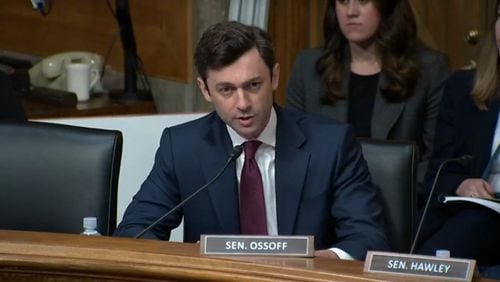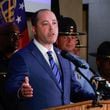ON VIEW
New works by Susie Pryor
Through July 25. 10 a.m.-5 p.m. weekdays, 11 a.m.-5 p.m. Saturdays. Pryor Fine Art, 764 Miami Circle, Suite 132, Atlanta. 404-352-8775, www.pryorfineart.com.
CHANGES AT ATLANTA GALLERIES
Decatur Market & Gallery: This art and crafts co-op recently closed after a six-and-a-half-year run. Founder Patrick Dennis is having a clearance sale of his atmospheric seascapes, original oils on canvas, through July 30. 1-4 p.m. Tuesdays-Saturdays. 153 Ponce de Leon Place, Decatur. 678-764-8737 or lawindle@gmail.com.
Mason Fine Art: Formerly an owner of Mason Murer Fine Art, the epic (24,000-square-foot) contemporary art gallery in the Armour Industrial District off I-85 and Monroe Drive, Mark Karelson has shortened his business's name and moved to a smaller space nearby. The opening group show, including works by Larry Walker, Terri Dilling and William Mize, is up through July 25. "OutsideIn," featuring Atlanta graffiti and street artists, opens July 31. 415 Plasters Ave., Atlanta. 404-879-1500, masonfineartandevents.com.
Marcia Wood Gallery: Longtime Atlanta gallery owner Wood took over the Midtown storefront in March once occupied by the now-defunct galleries Get This and Solomon Projects. Up through July 25 is "Surface Tension," assemblage works by Louisiana artist Shawne Major. Wood plans to maintain her Castleberry Hill location for more experimental undertakings and independent projects. 1037 Monroe Drive, Atlanta. 404-827-0030, marciawoodgallery.com.
Hagedorn Foundation Gallery: This Buckhead photography and contemporary art gallery closed abruptly in March, with an exhibit up that was to have run though mid-April. Its website nonetheless lists its hours as "Open by appointment only," though this could not be confirmed. 425 Peachtree Hills Ave., No. 25, Atlanta. www.hfgallery.org.
Pryor Fine Art is doing something only a handful of Atlanta galleries have been able to do: celebrate a 25th anniversary.
The gallery thick in the middle of Buckhead's Miami Circle design district is marking the occasion with a solo show of new work by owner Susie Pryor, a painter of attractive still lifes, evocative cityscapes and large figurative pieces.
With a stable of 60 North American artists, ranging from abstract painters to figurative sculptors, the 5,700-square-foot gallery is hard to pigeonhole. Yet it’s easy to see Pryor’s agreeable aesthetic at work and to understand why roughly half of its sales are tied to interior designers.
We talked to the 56-year-old artist-gallerist, who grew up in Athens and studied at the University of Georgia, about prevailing in a business that’s much like restauranteering, where even a decade’s run can be considered epic.
Q: What do you think the main factors are in your gallery’s longevity?
A: Luck!
Q: It’s got to be more than that, right?
A: I'd have say that staying flexible is critical. Because when you start a business, any entrepreneur would tell you, you have this idea of what you think it's going to be or what you can accomplish, and you get knocked from left and right. You're in a boxing ring and you're kind of fighting to stay up. … (So) you fine-tune what that dream is.
There are too many variables — the trends, the economy, the market you’re in, and having a full grasp on who the client is and how to match up the art that’s going to work for the audience it’s going to be in front of. There are a lot of variables that people will do studies on and think they have the answers to. But until you’re in the ring, you don’t really know.
Q: Is your artist sensibility reflected in the choices you make in terms of who the gallery represents, or is that not what you’re after?
A: I am (open to a mix) because I have appreciation across so many different genres and styles and levels of creativity in art. And yes, there's an aesthetic thread that will run through the gallery. But I think we're fairly diverse in what we show. That keeps it interesting and exciting. I don't want it to be limited and have boundaries of only work that is similar to what I do. In fact, I want quite the opposite.
Q: What is that thread then?
A: I kind of want to say that that thread has a level of beauty about it, but I hesitate to use that word because it can be misread as just being pretty and decorative.
Q: How would you characterize Atlanta as a gallery city?
A: I think Atlanta has grown in its tastes and expanded in its appreciation of art that is outside the box. Twenty to 25 years ago, you would've said Atlanta had such a conservative aesthetic, and it isn't anywhere near that now. It's much broader. And it's exciting, because bringing in artists who are doing more progressive things in their work and seeing (collectors) positively respond to it is one of the most exciting things that we do.
Q: Turning to your own art, what are you trying to express when you pick up a paintbrush?
A: I'm better at what I do if I'm not thinking about trying to convey something, if I'm not thinking about how it's going to feel to someone else. If I stay true to my process, true to myself, my best work comes when I'm really just painting for what feels good at that moment, that second, that instant that that color hits the canvas. Does it sing a song back to me or does it frustrate me? It's kind of a dialogue that I have going on, and my most expressive work is when I get my head out of it altogether and I'm not trying to do anything. I'm just there kind of in relationship to the paint.
Q: Why are children among your favorite subjects?
A: Children are completely free and not conscious of how they look, and there's a natural body language that you can read from a child that you don't get from an adult. My figurative work is about capturing that body language. It's not portrait work. It's the gesture.
Q: How much of your daily life is artist and how much gallery owner?
A: It's both all the time, unless I'm painting for a show of my own, which I have been for the last four months pretty solid (she's also represented by galleries in Boston and Charlotte, N.C.). Fortunately I can be on email. … I couldn't have gotten to 25 years without the kind of staff that I have. Otherwise, I wouldn't have this dual career.
About the Author





